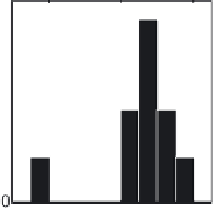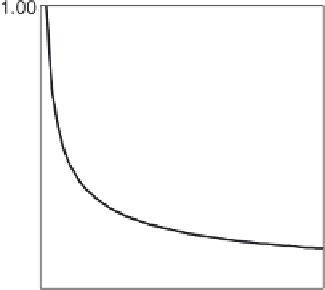Geoscience Reference
In-Depth Information
ka [Balco et al., 2008; cf. Zielinski and Davis, 1987; Gosse
and Klein, 1996]. The Waiho Loop moraine has a large
collection of radiocarbon dates that provide a minimum age
estimate [Denton and Hendy, 1994], although the signifi-
-
cance of these dates is debated [Broecker, 2003; Barrows et
al., 2007; Turney et al., 2007].
For our purposes, it is unimportant whether or not these
moraines belong to the Younger Dryas. It is sufficient that
they are late glacial or early Holocene in age (10
15 ka)
and have a comparatively large number of beryllium-10
exposure dates (n = 10 for the inner Titcomb Lakes mo-
raine; n = 8 for the Waiho Loop). Both of these moraines
also have exposure dates determined with other cosmogenic
nuclides [Barrows et al., 2007; Balco et al., 2008], but we
neglect these other measurements here; our model is most
appropriate for evaluating the distributions of beryllium-10
exposure dates.
For consistency, we have recalculated the exposure dates
from the inner Titcomb Lakes moraine following Barrows et
al. [2007]; see Table 1. We also recalculated the Waiho Loop
-
Figure 1.
Uncertainty of the weighted mean as a function of the
number of exposure dates available from a single moraine [Beving-
ton and Robinson, 2003, equation 4.19], normalized by the measure-
ment uncertainty of one exposure date. Figure 1 indicates the
minimum number of samples that should be taken from a moraine
in order to achieve a desired overall uncertainty. Because geomor-
phic processes also contribute to the scatter among exposure dates on
most moraines [Putkonen and Swanson, 2003; Balco and Schaefer,
2006; Ivy-Ochs et al., 2007], more samples will generally be needed.
suf
cient number of published, independent beryllium-10
exposure dates that we can have reasonable con
dence in
χ
χ
our age assignments (Figure 1).
Such moraines are rare. The Egesen stade moraines in
the Alps seem
firmly tied to the Younger Dryas [Ivy-Ochs
et al., 2006; cf. Kelly et al., 2004], but we know of no
Egesen moraine with more than four independent, pub-
lished beryllium-10 exposure dates. Because the Egesen I
and II moraines are geomorphically distinct in many Alpine
valleys [Ivy-Ochs et al., 2006], the age difference between
moraine crests within the Egesen stade is likely to be
substantial. This conclusion is supported by the exposure
dates from Julier Pass, Switzerland, where the difference in
the mean of the beryllium-10 exposure dates from the outer
and inner Egesen moraines is about 860 years [Ivy-Ochs
et al., 2007, Figure 4]. Hence, we do not combine exposure
dates from the Egesen I and II moraines to increase the
number of exposure dates.
Thus, we have chosen to use the beryllium-10 exposure
dates (Figure 2) from the inner Titcomb Lakes moraine
(Wind River Range, Wyoming [Gosse et al., 1995b]) and
from the Waiho Loop moraine in New Zealand [Barrows et
al., 2007, 2008; Applegate et al., 2008]. Each of these
moraines has some independent age control. The inner Tit-
comb Lakes moraine is correlated to the Temple Lake mo-
raine of Zielinski and Davis [1987], elsewhere in the Wind
River Range. The Temple Lake moraine is bracketed by
radiocarbon dates that indicate an age of about 12.0 calendar
Figure 2.
(top) Beryllium-10 exposure dates from the inner Titcomb
Lakes moraine [Gosse et al., 1995b] and the Waiho Loop moraine
[Barrows et al., 2007]. Both these data sets are likely influenced by
geomorphic processes. (bottom) We cannot rule out the hypothesis
that these data sets are drawn from normal distributions because the
dates fall fairly close to a line when displayed on normal probability
plots [Chambers et al., 1983]. However, the scatter in these data sets
is much larger than we would predict from the measurement un-
certainties of the individual dates; their reduced chi-squared (
v
2
R
)
[Bevington and Robinson [2003] scores are much larger than 1.



















































































Search WWH ::

Custom Search